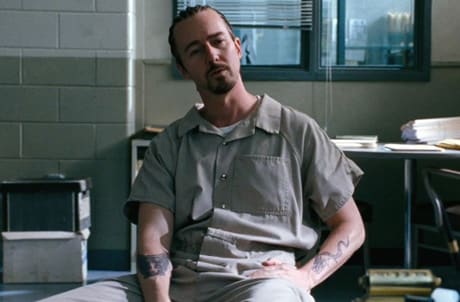Knowing John Curran's (We Don't Live Here Anymore, The Painted Veil) propensity for denying character catharsis, traditional morality arcs and conventional audience pleasure, Stone's anticlimactic subversion doesn't come as a great surprise.
Surely a mainstream cast and standard prison drama plotline about a parole officer and felon suggest predictability and digestible plot machinations, attracting a similar audience to Affleck's mediocre The Town, but I suspect most of those folks will be perplexed and pissed off by this borderline art-house yarn. Despite an immediate sense of impending menace, with a quiet domestic squabble and deliberately agitating, confrontational soundtrack, this brooding, fatalistic, gothic/religious story starts out unassuming enough.
Parole Officer Jack (Robert De Niro) is a man with a barely contained dark side, maintaining quiet complacency with his deeply unhappy, faith-driven wife, Madylyn (Frances Conroy), while preparing for retirement. In the process of wrapping up his cases, he's confronted by arsonist inmate Stone (Edward Norton), a cornrow-wearing urban thug that tosses out dialogue such as, "Damn, my girl's a ten, yo. She'll take it anywhere I put it, man" to a bemused De Niro.
His girl is schoolteacher Lucetta (Milla Jovovich), who is indeed brimming with alacrity and sexual energy, so much so that she's willing to seduce the elderly Jack for blackmail purposes to get her husband early parole.
Constant evangelical rants on background radios and a paralleling of theological identification with existential plight and the natural tendency towards weakness suggest sin and fear beneath the surface of everyone. Characters change but never speak their mind, either giving into their base instincts or embracing the idea of goodness through aesthetic change. Stone eventually finds a version of God, changing his attire and vernacular to suit his needs, while Jack's latent, unseemly tendencies become visible.
The grating sound as trajectory and uncomfortable close-ups keep the constant uneasy tone in check, even while the actual film rejects climax. This is a story more about loss of self through projected identity and repression as wearing force than lessons or slant. By the end, the real question is that of punishment for observed sins versus a life of freedom with constant subdued intent. How big is that divide and how much can a single moment really define someone?
(Alliance)Surely a mainstream cast and standard prison drama plotline about a parole officer and felon suggest predictability and digestible plot machinations, attracting a similar audience to Affleck's mediocre The Town, but I suspect most of those folks will be perplexed and pissed off by this borderline art-house yarn. Despite an immediate sense of impending menace, with a quiet domestic squabble and deliberately agitating, confrontational soundtrack, this brooding, fatalistic, gothic/religious story starts out unassuming enough.
Parole Officer Jack (Robert De Niro) is a man with a barely contained dark side, maintaining quiet complacency with his deeply unhappy, faith-driven wife, Madylyn (Frances Conroy), while preparing for retirement. In the process of wrapping up his cases, he's confronted by arsonist inmate Stone (Edward Norton), a cornrow-wearing urban thug that tosses out dialogue such as, "Damn, my girl's a ten, yo. She'll take it anywhere I put it, man" to a bemused De Niro.
His girl is schoolteacher Lucetta (Milla Jovovich), who is indeed brimming with alacrity and sexual energy, so much so that she's willing to seduce the elderly Jack for blackmail purposes to get her husband early parole.
Constant evangelical rants on background radios and a paralleling of theological identification with existential plight and the natural tendency towards weakness suggest sin and fear beneath the surface of everyone. Characters change but never speak their mind, either giving into their base instincts or embracing the idea of goodness through aesthetic change. Stone eventually finds a version of God, changing his attire and vernacular to suit his needs, while Jack's latent, unseemly tendencies become visible.
The grating sound as trajectory and uncomfortable close-ups keep the constant uneasy tone in check, even while the actual film rejects climax. This is a story more about loss of self through projected identity and repression as wearing force than lessons or slant. By the end, the real question is that of punishment for observed sins versus a life of freedom with constant subdued intent. How big is that divide and how much can a single moment really define someone?
